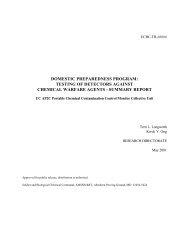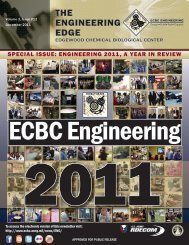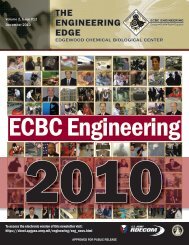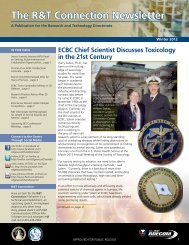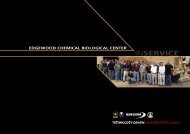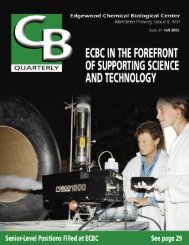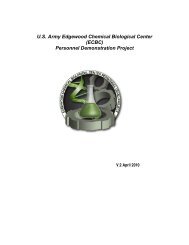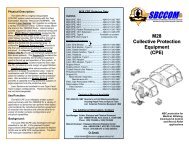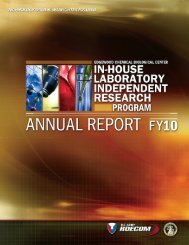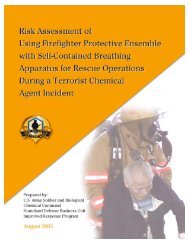The R&T Connection Newsletter - Edgewood Chemical Biological ...
The R&T Connection Newsletter - Edgewood Chemical Biological ...
The R&T Connection Newsletter - Edgewood Chemical Biological ...
Create successful ePaper yourself
Turn your PDF publications into a flip-book with our unique Google optimized e-Paper software.
<strong>The</strong> R&T <strong>Connection</strong> <strong>Newsletter</strong><br />
A Publication for the Research and Technology Directorate<br />
April 2011<br />
IN THIS ISSUE<br />
Senior Technologist Visits Germany...<br />
page 2<br />
Inter-Directorate Collaboration<br />
Resolves Issue... page 3<br />
R&T Scientist Speaks About<br />
Technologies... page 4<br />
Microbial Forensics Study Published...<br />
page 4<br />
Disability Committee Rep Completes<br />
Course... page 5<br />
Paper Published Linking Hardiness and<br />
Cholesterol... page 5<br />
BioSciences Staff Recognized with<br />
Awards... page 6<br />
Recent Staff Patents... page 6<br />
GFEBS Deployed in October... page 7<br />
International Obscurants Symposium...<br />
page 8<br />
Upcoming S&T Conferences/<br />
Meetings... page 8<br />
Connect to the Center<br />
Through Social Media<br />
Become a fan of ECBC on Facebook at:<br />
http://www.facebook.com/<br />
<strong>Edgewood</strong>ChemBioCenter<br />
Follow ECBC on Twitter at:<br />
http://twitter.com/<strong>Edgewood</strong>ChemBio<br />
View videos of ECBC on YouTube<br />
at: http://www.youtube.com/<br />
edgewoodchembio<br />
View photos of ECBC on Flickr at:<br />
http://www.flickr.com/photos/<br />
edgewoodchembiocenter<br />
R&T <strong>Connection</strong><br />
Have an item for the R&T<br />
<strong>Connection</strong>? Whether it’s a<br />
technical accomplishment, an<br />
upcoming speech, an employee<br />
award or any other news<br />
story, please share it with R&T<br />
Communications Officer Mia<br />
Scharper at mia.scharper@<br />
us.army.mil or 410.436.2262.<br />
Message from the Director<br />
Well-deserved congratulations to Ms. Suzanne Milchling on<br />
behalf of the Research and Technology Directorate! Ms. Milchling<br />
was appointed by the Secretary of Army as the Director of<br />
Program Integration, and she is the first female Senior Executive<br />
Service member at ECBC. Not only does she have extensive<br />
experience and a talent for getting things done, but she has<br />
proven that she keeps the warfighter – our ultimate customer<br />
– as her first priority. As director, Ms. Milchling manages the<br />
business activities and operating processes at ECBC, and directs<br />
interagency activities with organizations such as the Department<br />
of Homeland Security, Environmental Protection Agency,<br />
Department of Energy, as well as various state/local government<br />
and commercial entities with chemical and biological protection<br />
homeland security responsibilities. I’m very much looking forward<br />
to working with Ms. Milchling in this new role.<br />
I’d also like to extend congratulations to you for displaying such flexibility and professionalism<br />
through the talk of the possible government shutdown. I am pleased that a continuing<br />
resolution was passed in the nick of time and appreciate your patience throughout this process.<br />
Once again, you have demonstrated why R&T people are truly extraordinary. Thank you for<br />
your support during this process, and I know you will continue to deliver great work for our<br />
clients.<br />
Putting SharePoint<br />
to Work for You<br />
Is your team using SharePoint yet? If<br />
not, please visit https://ecbcsharepoint.<br />
apgea.army.mil to explore this tool. You’ll<br />
notice that within R&T, each division and<br />
branch has its own page, which can be<br />
customized as you like. Teams can add<br />
work pages and set specific permissions.<br />
SharePoint has become a staple work<br />
product for many of ECBC’s employees<br />
and leadership during the last few years.<br />
Teams use it to facilitate knowledge<br />
management and collaboration, and now<br />
that ECBC has dedicated support staff<br />
and training available, it makes sense to<br />
think about how you can put SharePoint<br />
to work. Please watch your email for<br />
training opportunities.<br />
EDGEWOOD CHEMICAL BIOLOGICAL CENTER<br />
RESEARCH & TECHNOLOGY<br />
Approved for Public Release<br />
Approved for Public Release<br />
. .<br />
1
<strong>The</strong> R&T <strong>Connection</strong> <strong>Newsletter</strong><br />
A Publication for the Research and Technology Directorate<br />
April 2011<br />
Senior Technologist Visits Germany in Exchange Program<br />
Jose-Luis Sagripanti, Ph.D., senior<br />
technologist in biochemistry<br />
at the U.S. Army <strong>Edgewood</strong><br />
<strong>Chemical</strong> <strong>Biological</strong> Center (ECBC),<br />
spent six months in Munster,<br />
Germany, leading research at the<br />
Wehrwissenschaftliches Institut für<br />
Schutztechnologien - ABC-Schutz<br />
(WIS).<br />
During his time at WIS, Sagripanti<br />
directed many activities, including<br />
experiments on the microbial<br />
effectiveness of chemical disinfectants,<br />
the photochemical inactivation of<br />
viruses and bacteria, and an electron<br />
microscopy for microbial structural<br />
effects of inactivating agents on<br />
bacteria and viruses.<br />
<strong>The</strong> organization’s name translates to<br />
the Research Institute for Protective<br />
Technologies and Nuclear, <strong>Biological</strong><br />
and <strong>Chemical</strong> Protection. WIS is<br />
ECBC’s sister organization in Germany,<br />
said Sagripanti, who worked at<br />
the institute from April 2010 to<br />
October 2010 under the U.S. Army-<br />
Bundeswehr Exchange Technical<br />
Officers Program. Experts in their<br />
field are selected to participate in this<br />
Pentagon-managed program.<br />
Before his six-month rotational<br />
assignment, Sagripanti had already<br />
contributed his expertise to WIS by<br />
providing journal article reprints and<br />
speaking at WIS’s annual conference.<br />
“I must have fooled them into thinking<br />
I knew something, so they invited me<br />
for an extended stay,” he said with his<br />
characteristic blend of modesty and<br />
humor.<br />
<strong>The</strong> director of WIS, Roland Dierstein,<br />
Ph.D., noted that Sagripanti was both<br />
“a human asset and a great scientific benefit to our institute<br />
and the international cooperation in a very interesting and<br />
pioneering project.” Sagripanti’s project was called “Universal<br />
Microbial Inactivation for Safe and Rapid Diagnostics of<br />
<strong>Biological</strong> Threat Agents.”<br />
Sagripanti said that he enjoyed working at WIS, noting that<br />
he worked with approximately 40 scientists, who were<br />
especially responsive and professional.<br />
While in Berlin, Jose-Luis Sagripanti, Ph.D., visited<br />
the Robert Koch Institute. (Source: Bredow, Robert<br />
Koch Institute)<br />
Sagripanti also delivered lectures on<br />
threat characterization and biodefense.<br />
Sagripanti’s team tested a wide<br />
variety of microbicidal compounds<br />
on the survival of vegetative bacteria,<br />
bacterial spores, DNA viruses and<br />
RNA viruses; the performance of<br />
DNA-based detection and diagnostic<br />
methods; and the performance<br />
of immune-based detection and<br />
diagnostic methods. <strong>The</strong> team<br />
discovered chemical compositions that<br />
completely kill all the tested organisms<br />
while preserving the performance of<br />
detection and diagnostic methods.<br />
While in Germany, Sagripanti was<br />
invited to speak to the medical<br />
command in Munich and the Robert<br />
Koch Institute in Berlin. “I received the<br />
red carpet treatment there,” he said.<br />
Sagripanti spoke to several hundred<br />
people in Berlin about his recent<br />
research projects at WIS.<br />
He was one of the few visitors invited to visit the mausoleum<br />
that holds Koch’s remains. “Being so close to a giant in the<br />
microbiology field was an unbelievable experience,” he said. “I<br />
was really touched.”<br />
Sagripanti said that his time in Germany was an impressive<br />
experience professionally. WIS “is a well-run, very efficient<br />
organization,” he said.<br />
EDGEWOOD CHEMICAL BIOLOGICAL CENTER<br />
. .<br />
RESEARCH & TECHNOLOGY<br />
Approved for Public Release<br />
2
<strong>The</strong> R&T <strong>Connection</strong> <strong>Newsletter</strong><br />
A Publication for the Research and Technology Directorate<br />
Inter-Directorate Collaboration Resolves VX Monitoring Issue<br />
R&T’s Analytical Toxicology Branch collaborated<br />
with DPI’s Environmental Monitoring Laboratory<br />
to resolve a nagging issue with the existing<br />
methods being used to monitor for VX. <strong>The</strong><br />
collaboration led to the development of a new<br />
method that – in addition to resolving previous<br />
issues – offers lower detection limits and a<br />
decreased percentage of false positives in<br />
comparison to the former monitoring methods.<br />
Additionally, it improved the quality, accuracy and<br />
efficiency of the skills and services ECBC provides<br />
to customers.<br />
“This method represents a significant improvement<br />
in both selectivity and sensitivity by analyzing<br />
for VX directly using advanced instrumentation,<br />
using a second ion transition for confirmation<br />
purposes in the same analysis,” said Ron Evans,<br />
a chemist with the Analytical Toxicology Branch.<br />
“<strong>The</strong> method does not consume the entire sample,<br />
which allows for further investigation if necessary.”<br />
April 2011<br />
<strong>The</strong> new analysis method is discussed in an article<br />
published in February 2011 in Analytical Chemistry.<br />
<strong>The</strong> article is titled “Quantification of VX Vapor in<br />
Ambient Air by Liquid Chromatography Isotope<br />
Dilution Tandem Mass Spectrometric Analysis of<br />
Glass Bead Filled Sampling Tubes.”<br />
According to Michael Jakubowski, chief of the<br />
Analytical Toxicology Branch, “This project utilized<br />
the expertise of the personnel of both branches<br />
to develop a method that is capable of being<br />
transferred from one laboratory to another. <strong>The</strong><br />
exchange of ideas and the cooperative use of<br />
materials between the laboratories allowed the<br />
method to be developed and validated in a manner<br />
that satisfies the needs of the air monitoring<br />
program.”<br />
Chemist Ron Evans holds a glass-bead filled DAAMS tube used to collect air<br />
samples. <strong>The</strong> instrument used for the sample analysis is a combination of a<br />
liquid chromatograph and tandem mass spectrometer, which allows for trace<br />
level detection of VX.<br />
“<strong>The</strong> use of this monitoring technology across<br />
the Center has resulted in improved quality and<br />
confidence for data results for worker protection,<br />
lab safety and the clearing of laboratory<br />
wastes,” said John Schwarz, a chemist with DPI’s<br />
Environmental Monitoring Laboratory.<br />
EDGEWOOD CHEMICAL BIOLOGICAL CENTER<br />
. .<br />
RESEARCH & TECHNOLOGY<br />
Approved for Public Release<br />
3
<strong>The</strong> R&T <strong>Connection</strong> <strong>Newsletter</strong><br />
A Publication for the Research and Technology Directorate<br />
April 2011<br />
R&T Scientist Speaks About<br />
Next Generation Sequencing<br />
Technologies<br />
Did you know that U.S. Army<br />
<strong>Edgewood</strong> <strong>Chemical</strong> <strong>Biological</strong><br />
Center (ECBC) experts<br />
frequently speak at international<br />
conferences? Scientist Lauren<br />
McNew of R&T’s BioChemistry<br />
Branch spoke to an audience<br />
of 400 attendees at the 12th<br />
annual Advances in Genome<br />
Biology and Technology<br />
Conference (AGBT), held in<br />
Florida in February.<br />
McNew spoke about next<br />
generation sequencing<br />
technologies for rapid response<br />
to bio threat events and included<br />
ECBC scientist Lauren<br />
McNew spoke about next<br />
generation sequencing<br />
technologies at the 12th<br />
annual Advances in Genome<br />
Biology and Technology<br />
Conference.<br />
information about operational exercises being conducted in<br />
the ECBC Genomics Center to respond to potential biological<br />
threats.<br />
<strong>The</strong> AGBT meeting has become the most complete<br />
scientific forum for acquiring information about the latest<br />
advances in DNA sequencing technologies and their<br />
myriad applications. Attendees represent both national<br />
and international organizations from the fields of cancer<br />
genomics, metagenomics, genomic and personalized<br />
medicine, population and evolutionary genomics, and societal<br />
implications of genomics research, as well as cutting-edge<br />
bioinformatics technologies.<br />
“<strong>The</strong> AGBT meeting is the most visible international genomic<br />
sequencing meeting,” said McNew. “<strong>The</strong> inclusion of<br />
ECBC and its applications for next generation sequencing<br />
has allowed us to bring forth the capability of the center<br />
to those who would not otherwise be aware of our work.<br />
This year, there was a marked increase in presentations for<br />
biosurveillance and biodefense applications. I believe this trend<br />
will continue going forward creating a niche for ECBC and<br />
other government agencies to fill given our ability to perform<br />
genomics ‘behind the fence’ for microbial forensics.”<br />
Microbial Forensics Study on<br />
Historical Biowarfare Simulant<br />
Published<br />
H. Sandy Gibbons, Ph.D., of R&T’s<br />
BioSciences Division, recently published<br />
“Genomic signatures of strain selection<br />
and enhancement in Bacillus atrophaeus<br />
var. globigii, a historical biowarfare<br />
simulant” in the journal PLoS One.<br />
<strong>The</strong> study uses high-throughput<br />
genomic sequencing to detail the<br />
strain history of B. atrophaeus and its<br />
adaptation for use as a simulant strain<br />
in the biodefense community during<br />
the 1940s. In particular, the study notes<br />
H. Sandy Gibbons,<br />
Ph.D.<br />
that the strains transferred to Camp Detrick were deliberately<br />
“enhanced,” beginning with an adaptation to the medium<br />
used to grow the strains, then by selection of a mutant<br />
that sporulated readily. <strong>The</strong> approach to identifying these<br />
mutations is broadly applicable to the emerging science of<br />
microbial forensics.<br />
“This study sets a framework for interpreting and assigning<br />
meaning to very large data sets and also to the function and<br />
effects of mutations that initially seem uncertain,” Gibbons<br />
said. “We are now a step closer to rapidly identifying an<br />
organism as enhanced, engineered or as a particularly<br />
threatening natural isolate. And, the knowledge that we<br />
have generated can be used to develop future detection<br />
technologies and assays.”<br />
“I am extremely proud of the relevant work ECBC’s employees<br />
contribute to the greater CB community every day,” said ECBC<br />
Technical Director Joseph Wienand. “<strong>The</strong> research detailed in<br />
this report not only advances technology in microbial forensics,<br />
but more importantly helps protect the warfighter and<br />
homeland against potential emerging biological threats.”<br />
<strong>The</strong> work, led by Gibbons, involved an interdisciplinary team<br />
of microbiologists, sequencing experts, bioinformaticists<br />
and statisticians. Scientists that played an integral role in its<br />
completion include ECBC Biologist Stacey Broomall, Research<br />
Microbiologist Lauren McNew and Research Biologist Nicole<br />
Rosenzweig, Ph.D. as well as Research Associate Carol<br />
Chapman from the Naval Medical Research Center and Faculty<br />
Associate John Lindquist from the University of Wisconsin’s<br />
Bacteriology Department.<br />
EDGEWOOD CHEMICAL BIOLOGICAL CENTER<br />
. .<br />
RESEARCH & TECHNOLOGY<br />
Approved for Public Release<br />
4
<strong>The</strong> R&T <strong>Connection</strong> <strong>Newsletter</strong><br />
A Publication for the Research and Technology Directorate<br />
April 2011<br />
Disability Committee Rep Completes SEPM Course<br />
Patricia Reeves, an R&T technical writer and editor, recently<br />
completed the Special Emphasis Program Manager (SEPM)<br />
course at the Defense Equal Opportunity Management Institute<br />
at Patrick Air Force Base in Florida. <strong>The</strong> course will allow Reeves<br />
to serve more effectively as ECBC’s representative on the APG<br />
Disability Committee.<br />
This training focused on inter- and intrapersonal and<br />
organizational aspects of Equal Employment Opportunity<br />
(EEO), the causes and effects of discrimination, EEO programs<br />
for federal employees, civilian personnel management and<br />
the value of diversity. <strong>The</strong> training concentrated on the roles<br />
and responsibilities of SEPMs, communication skills, staff<br />
coordination, briefing skills, analyzing EEO data, and planning<br />
and managing effective Special Emphasis Programs.<br />
“<strong>The</strong> course was very intense,” Reeves said. “One of our activities<br />
included briefing a make-believe general (an instructor) about<br />
what the SEPM would do for an organization.”<br />
To help our customers and the APG workforce, Reeves<br />
volunteered to be a member of the APG Disability Committee to<br />
improve the work environment for people who are disabled and<br />
other challenged employees, educate people about disabilities<br />
and open opportunities for people with disabilities.<br />
In addition to serving<br />
on the Disability<br />
Committee, Reeves coteaches<br />
free beginner<br />
American Sign<br />
Language classes in the<br />
fall and spring at APG,<br />
and she has provided<br />
interpreter services for<br />
government personnel.<br />
To advance her interest<br />
in this area, Reeves<br />
has applied for the<br />
Disability Program<br />
Management course in<br />
July 2011. Through her<br />
participation in these<br />
activities, Reeves hopes<br />
Patricia Reeves poses with her SEPM<br />
classmates at the Defense Equal<br />
to help those with<br />
Opportunity Management Institute.<br />
disabilities and increase<br />
Reeves is pictured third from rear on the<br />
awareness. “I’m a very<br />
far left.<br />
strong advocate for<br />
people who are deaf or disabled,” she said.<br />
Paper Published Linking Psychological Hardiness and Cholesterol<br />
Jay Valdes, Ph.D., ECBC’s senior technologist in biotechnology,<br />
co-authored a paper that will be presented as a poster at the<br />
May 2011 meeting of the Association for Psychological Science.<br />
<strong>The</strong> paper, “Biomarkers for Hardiness-Resilience: Psychological<br />
Hardiness Is Linked to Baseline Cholesterol Levels in Healthy<br />
Adults,” was co-authored with Paul Bartone, Ph.D., senior<br />
research fellow at the National Defense University (NDU); Tony<br />
Spinosa, director of the NDU Health & Fitness Directorate; and<br />
Lt. Col. Joel Robb, U.S. Air Force.<br />
<strong>The</strong> psychological characteristic of “hardiness” or “resilience”<br />
has been clearly linked to physiological response to stressors<br />
including susceptibility to disease, ability to survive stressful<br />
situations such as captivity, and may be implicated in posttraumatic<br />
stress disorder (PTSD) and suicide.<br />
“<strong>The</strong> psychological correlates of hardiness/resilience are quite<br />
robust,” said Valdes. “Identifying underlying biomarkers<br />
would allow us to predict performance during stress, as well as<br />
possible points of intervention to lessen the effects of PTSD and<br />
traumatic brain injury. Such an application of personal medicine<br />
is still some years away.“<br />
<strong>The</strong> experimental subjects in this study were military and civilian<br />
students from the National War College and the Industrial<br />
College of the Armed Forces, classes of 2009 and 2010.<br />
Statistical support was provided by the University of Bergen in<br />
Norway. Future work will be focused on developing a panel of<br />
biomarkers with more powerful predictive ability.<br />
EDGEWOOD CHEMICAL BIOLOGICAL CENTER<br />
. .<br />
RESEARCH & TECHNOLOGY<br />
Approved for Public Release<br />
5
<strong>The</strong> R&T <strong>Connection</strong> <strong>Newsletter</strong><br />
A Publication for the Research and Technology Directorate<br />
BioSciences Staff Recognized With Bronze Awards<br />
Three BioSciences staff members have been selected to<br />
receive Bronze 2011 Excellence in Federal Career Awards.<br />
Lalena Wallace and<br />
Lisa Smith, of the<br />
BioDefense Branch,<br />
will receive a medal<br />
for Outstanding<br />
Scientific Support<br />
Team. Sandy<br />
Leonard, project<br />
support assistant for<br />
the BioChemistry<br />
Branch, will receive<br />
a medal for Rookie<br />
Employee of the<br />
Year.<br />
Sandy Leonard Lalena Wallace Lisa Smith<br />
April 2011<br />
National Homeland Security Research Center, and Testing of Hot<br />
Air as a Non-invasive Decon Technology for Aircraft Interior from<br />
the Defense Threat Reduction Agency’s<br />
Joint Science and Technology Office. In<br />
addition, Wallace provided significant input<br />
to the conceptual development of novel<br />
Ricin bioassay.<br />
“Congratulations to Lalena and Lisa for<br />
being selected as winners,” said Vipin<br />
Rastogi, Ph.D., of the BioDefense Branch,<br />
who nominated the two biologists. “<strong>The</strong>y<br />
represent a symbol of maturity, integrity,<br />
and utmost professionalism at work place<br />
blended with an even temper, team spirit,<br />
and safe work ethics.<br />
Wallace and Smith<br />
are being recognized<br />
for their technical<br />
contributions in a<br />
number of high-profile programs, including Test Methods<br />
Development from the U.S. Environmental Protection<br />
Agency’s (US EPA’s) Office of Pesticide Programs, Detection of<br />
Biowarfare pathogen in Drinking Water and Development of<br />
Novel Bioassay for the Detection of Ricin Toxin from US EPA’s<br />
“Sandy has performed at an exceptional<br />
level in developing and maintaining<br />
the programmatic operations of the<br />
BioChemistry Branch,” said Branch Chief<br />
Jim Carney. “Consequently, she has been an invaluable asset to<br />
me in carrying out the job of branch chief.”<br />
<strong>The</strong> staff members will receive their awards during an awards<br />
luncheon in Baltimore May 6.<br />
Recent Staff Patents<br />
Patent #7,838,476, Generation of Residue-Free<br />
Decontaminant Using Hydrogen Peroxide, Ammonia, and<br />
Carbon Dioxide, Dr. George Wagner<br />
Patent #7,829,519, Decontamination of <strong>Chemical</strong> Warfare<br />
Agents Using Benign Household <strong>Chemical</strong>s, Dr. George<br />
Wagner<br />
Patent #7,852,469, Particle Detector, David Sickenberger<br />
Patent #7,862,773, Purification Method and Apparatus,<br />
Dr. M. Sofi Ibrahim<br />
Patent #7,850,908, Detecting Bacteria by Direct Counting of<br />
Structural Protein Units or Pili by IVDS and Mass Spectrometry,<br />
Dr. Charles Wick<br />
Patent #7,838,227, Simultaneous Detection of <strong>Biological</strong><br />
Agents by Solid-State Hybridization and Naked Eye Visualization,<br />
Dr. Jose-Luis Sagripanti<br />
Patent #7,851,207, Multiplex Field Device to Detect and Identify<br />
a Variety of Microbial Agents Simultaneously, Dr. Jose-Luis<br />
Sagripanti<br />
Patent #7,861,719, High Surface Area <strong>Chemical</strong>/<strong>Biological</strong><br />
Air-Purifying Filter, Corey Grove and Daniel Barker<br />
EDGEWOOD CHEMICAL BIOLOGICAL CENTER<br />
. .<br />
RESEARCH & TECHNOLOGY<br />
Approved for Public Release<br />
6
<strong>The</strong> R&T <strong>Connection</strong> <strong>Newsletter</strong><br />
A Publication for the Research and Technology Directorate<br />
April 2011<br />
GFEBS to Be Deployed at ECBC in October<br />
<strong>The</strong> General Fund<br />
Enterprise Business<br />
System (GFEBS)<br />
(Wave 7) will be<br />
deployed on Oct.<br />
1, 2011 to the U.S.<br />
Army <strong>Edgewood</strong><br />
<strong>Chemical</strong> <strong>Biological</strong><br />
Center (ECBC).<br />
GFEBS is the Army’s web-enabled financial, asset and accounting<br />
management system that standardizes, streamlines and shares<br />
critical data across the active Army, Army National Guard and<br />
Army Reserve organizations.<br />
Once fully deployed, GFEBS will replace numerous legacy<br />
systems and interface with existing systems like the Defense<br />
Travel System, making GFEBS one of the world’s largest<br />
government Enterprise Resource Planning systems. <strong>The</strong> primary<br />
goal of GFEBS is to capture transactions and provide reliable and<br />
current information through a single system, enabling all levels<br />
of Army leadership to make better decisions in support of the<br />
warfighter.<br />
R&T personnel will work with six of the nine modules<br />
available: Finance, Funds Management, Spending Chain, Cost<br />
Management, Reimbursables and Project Systems. After meeting<br />
with personnel in all R&T divisions to collect information<br />
regarding functions that are completed within legacy systems,<br />
the R&T Directorate has identified personnel roles to the GFEBS<br />
Group. <strong>The</strong>se assigned roles correlate with tasks currently<br />
performed in legacy systems and those that will be completed<br />
when GFEBS is deployed.<br />
If you have an assigned role, you must complete the Common<br />
Core courses L101E, L201E, and L303E, which are accessible<br />
through the Army Learning Management System (ALMS)<br />
website. Additional training may be necessary, depending<br />
upon the roles assigned. Additional role-specific training will be<br />
identified in the ALMS computer-based training (CBT) system;<br />
at a later date, further direction will be distributed. Without the<br />
required training, you will not be able to complete transactions<br />
within the GFEBS. For example, if you currently submit PCMS/<br />
WRAPS requests and have not completed the training for the<br />
GFEBS roles associated with these types of transactions, you will<br />
be unable to submit requests for purchases.<br />
Michelle Zadroga, financial management analyst, is the R&T<br />
Directorate GFEBS power user and role coordinator. <strong>The</strong>se roles<br />
have required her to attend over 150 hours of CBT and 160<br />
classroom hours learning about GFEBS and its processes.<br />
“GFEBS will change the way ECBC does business,” Zadroga<br />
said. “It will take longer to execute transactions because of<br />
the additional steps required to complete activities within the<br />
GFEBS system and personnel will be learning to operate within a<br />
whole new system. <strong>The</strong> exceptional talent at ECBC will be able<br />
to overcome the GFEBS learning curve; it will just take time and<br />
patience.”<br />
If you need a role within GFEBS, contact Zadroga. Those holding<br />
roles within GFEBS should be on the lookout for an invitation to<br />
attend a GFEBS briefing conducted by Zadroga.<br />
Mark Your Calendar!<br />
In honor of Military Appreciation Month, the<br />
Engineering Directorate will host an “ECBC Military<br />
Appreciation Day” event on May 16 from 11:30 AM<br />
- 1 PM at the APG-EA <strong>The</strong>ater. <strong>The</strong> purpose of the<br />
event is to honor those members of the workforce<br />
who have served or are actively serving in the<br />
U.S. military. <strong>The</strong> ECBC workforce is encouraged<br />
to attend to honor fellow employees, and hear<br />
experiences from their time serving in the military.<br />
<strong>The</strong> format is a networking lunch followed by a<br />
formal agenda including brief remarks from several<br />
prominent members of the ECBC workforce, including<br />
R&T Senior Technologist Dr. Fountain, and a group<br />
presentation honoring all of the ECBC employees who<br />
have served in the military. Lunch will be available for<br />
purchase.<br />
For more information about the event, please contact<br />
Ed Bowen at ed.bowen@us.army.mil.<br />
EDGEWOOD CHEMICAL BIOLOGICAL CENTER<br />
. .<br />
RESEARCH & TECHNOLOGY<br />
Approved for Public Release<br />
7
<strong>The</strong> R&T <strong>Connection</strong> <strong>Newsletter</strong><br />
A Publication for the Research and Technology Directorate<br />
April 2011<br />
Bickford and Hale Coordinate<br />
International Obscurants Symposium<br />
Larry Bickford and Jeff Hale of R&T’s Smoke and Target Defeat Branch have been<br />
planning the 2011 Obscurants Symposium, “21st Century Countermeasures for the<br />
21st Century Warfighter.” <strong>The</strong> symposium, slated for May 10-12 at the Baltimore<br />
Convention Center, will host government, industry, contractors and academia from<br />
across the United States as well as other international partners. <strong>The</strong> symposium<br />
will foster idea sharing across the obscurants community, highlight emerging<br />
technologies, identify opportunities for collaboration and reinforce the fact that<br />
obscurants are an important factor in survivability that save soldiers’ lives and<br />
safeguard equipment and tools essential for battle.<br />
U.S. Army Staff Sgts. Patrick Sumey and Terry Cooper sprint through the fog from a<br />
smoke canister as students and instructors look on during a training exercise. (U.S.<br />
Army photo)<br />
Upcoming S&T Conferences/Meetings<br />
R&T staff get around! This list is just a sampling of the many conferences and<br />
workshops we will be supporting in the coming months.<br />
• SPIE Laser Conference, April 25-29, 2011, Orlando, FL link<br />
• Obscurants Symposium, May 10-12, 2011, Baltimore, MD<br />
Hold the Date!<br />
Organizational<br />
Day Picnic<br />
• American Society for Mass Spectrometry Conference, June 5-9, 2011, Denver, CO link<br />
• CBRN 2011/Regimental Week, June 21-23, 2011, Fort Leonard Wood, MO link<br />
• IEEE International Geoscience and Remote Sensing Symposium (IGARSS), August 1-5,<br />
2011, Sendai, Japan link<br />
• Society of Environmental Toxicology and Chemistry 32nd Annual Meeting, November<br />
13 - 17, 2011, Boston, MA link<br />
• CBD S&T Conference, November 14-18, 2011, Las Vegas, NV link<br />
• Partners in Environmental Technology Technical Symposium & Workshop, November<br />
29 - December 1, 2011, Washington, DC link<br />
JULY 28, 2011<br />
EDGEWOOD CHEMICAL BIOLOGICAL CENTER<br />
. .<br />
RESEARCH & TECHNOLOGY<br />
Approved for Public Release<br />
8



